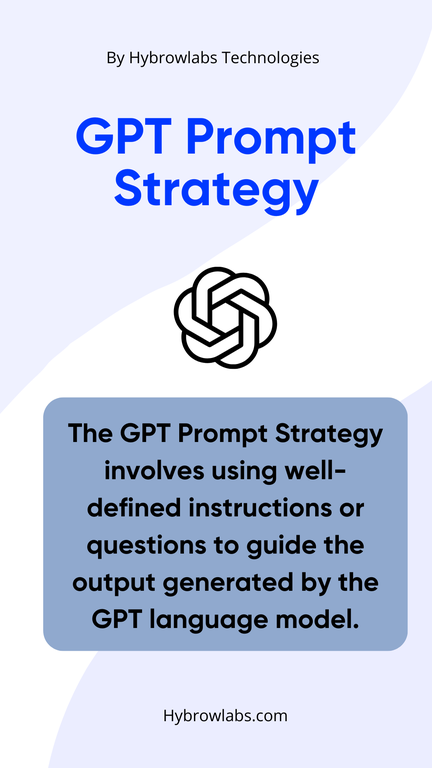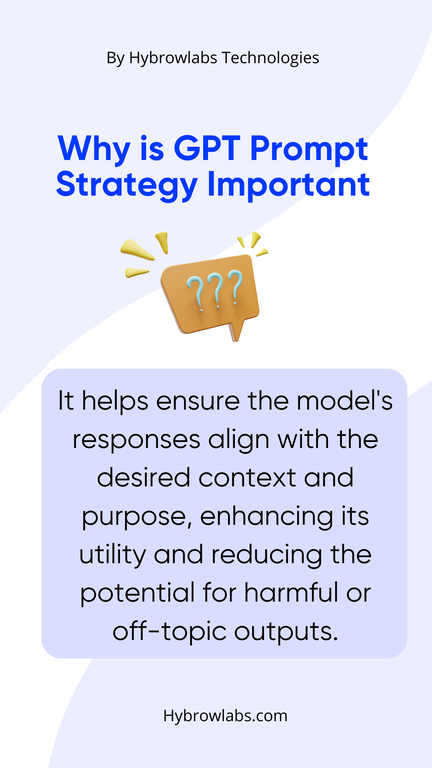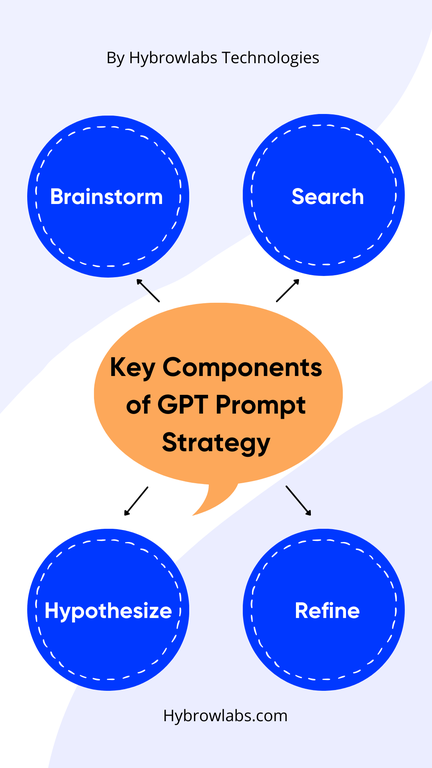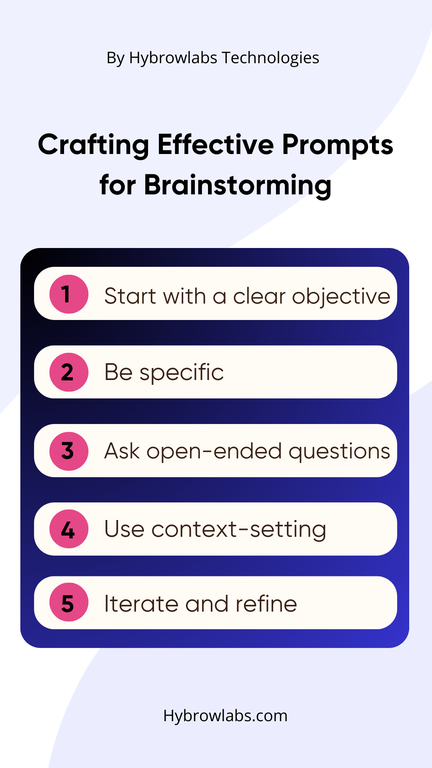In the rapidly evolving landscape of artificial intelligence, GPT prompt strategy has emerged as a fundamental tool for unlocking the full potential of AI language models. To harness this technology effectively, users need a well-structured strategy that comprises key components - Brainstorm, Search, Hypothesize & Refine. In this blog, we will explore the components of GPT prompt strategy & their significance, guiding you through the journey of maximizing the capabilities of AI language models. So let’s start by knowing
What is GPT Prompt Strategy?

GPT prompt strategy is the process of designing, creating & evaluating prompts for GPT models. GPT models are large language models that can generate text, translate languages, write different kinds of creative content & answer your questions in an informative way. However, GPT models need to be prompted with clear & concise instructions in order to generate the desired output.
GPT prompt strategy is important because it allows users to get the most out of GPT models. By carefully crafting their prompts, users can guide GPT models to generate outputs that are more relevant, accurate & creative. Additionally, GPT prompt strategy can help users to avoid common pitfalls, such as generating outputs that are off-topic, nonsensical, or harmful.
Why is GPT Prompt Strategy Important?

Here are some of the benefits of using GPT prompt strategy:
1. Generate more relevant and accurate outputs:
By providing GPT models with clear & concise instructions, users can guide them to generate outputs that are more relevant to the task at hand & more accurate in terms of factual content.
2. Generate more creative outputs:
GPT models can be used to generate a wide range of creative content, such as poems, stories, scripts & musical pieces. By using GPT prompt strategy, users can guide GPT models to generate creative outputs that are tailored to their specific needs & preferences.
3. Improve productivity and creativity:
GPT prompt strategy can help users to improve their productivity & creativity by automating tasks that would otherwise be time-consuming & tedious. Additionally, GPT prompt strategy can help users to generate new ideas & perspectives that they may not have thought of on their own.
4. Avoid common pitfalls:
GPT models are still under development and can make mistakes. However, GPT prompt strategy can help users to avoid common pitfalls, such as generating outputs that are off-topic, nonsensical, or harmful.
GPT Prompt Strategy, Main Components: Brainstorm, Search, Hypothesize And Refine:-

GPT prompt strategy is a systematic approach to optimizing interactions with AI language models like GPT-4. It consists of four key components: Brainstorm, Search, Hypothesize & Refine.
Brainstorm: Creative generation of ideas & keywords to shape the prompt.
Search: Collection of relevant information to inform the AI model.
Hypothesize: Crafting a clear, testable hypothesis to serve as a guiding objective for the model's response.
Refine: Iterative process to hone the clarity & specificity of the instruction, allowing users to harness the full potential of these AI models for accurate & valuable outputs.
Update:
- GPT-3.5 is now GPT-4.
- GPT-4 is a more powerful and versatile language model than GPT-3.5.
- GPT-4 can be used for a wider range of tasks, including generating creative text formats, translating languages, writing different kinds of creative content & answering your questions in an informative way.
Implications for GPT prompt strategy:
- GPT-4 can generate more complex and nuanced outputs than GPT-3.5.
- GPT-4 is better at understanding and responding to prompts that are clear, concise & specific.
- GPT-4 can be used to generate outputs in a wider range of creative text formats.
Now let’s explore the GPT Prompt Strategy deeply
1. Brainstorm:
Imagine yourself in a brainstorming session with a team of AI experts. You're all sitting around a whiteboard, throwing out ideas for GPT prompts. Some of the ideas are wild & crazy, but that's okay. The goal is to come up with as many ideas as possible, no matter how outlandish they may seem.
One way to brainstorm GPT prompts is to start with a specific task or goal in mind. For example, if you want to use GPT to generate a creative poem, you might brainstorm prompts like:
- Write a poem about a robot who falls in love with a human.
- Write a poem in the style of Shakespeare about a modern-day problem.
- Write a poem that uses only words that start with the letter "A".
Another way to brainstorm GPT prompts is to think about different types of content that you can generate with GPT. For example, you could brainstorm prompts for:
- Blog posts
- Articles
- Stories
- Poems
- Scripts
- Code
- Musical pieces
Once you have a list of potential GPT prompts, you can start to narrow it down by considering the tone & style of the output you want to generate. For example, if you want to generate a formal article for a business website, you would choose different prompts than if you wanted to generate a humorous blog post for your personal website.
Here are a few tips for brainstorming GPT prompts:
- Be as specific as possible: The more specific you are, the better GPT will be able to understand what you want & generate the desired output.
- Use clear & concise language: Avoid using jargon or technical terms that GPT may not be familiar with.
- Provide GPT with examples of the type of output you want to generate: This will help GPT to better understand your expectations.
- Consider the tone & style of the output you want to generate: GPT can generate outputs in a variety of tones and styles, from formal to informal, from serious to humorous.
2. Search:
Once you have a few potential GPT prompts in mind, you can use search engines to find additional prompts & examples. This can be helpful for finding prompts that are specific to your niche or topic.
For example, if you're writing a blog post about the latest trends in artificial intelligence, you could search for "GPT prompts for AI blog posts". Or, if you're writing a story about a robot who falls in love with a human, you could search for "GPT prompts for robot love stories".
You can use search engines to find GPT prompts, but you can also look for prompts in other places, such as:
- Academic journals
- Industry blogs
- AI communities
- Social media
- Online forums
When evaluating the quality of GPT prompts, look for prompts that are:
- Clear and concise
- Provide GPT with enough information to generate the desired output
- Relevant to your specific needs and preferences
You can also look for prompts that have been shared by other users & have a good track record of generating high-quality outputs.
3. Hypothesize:
Once you have a list of high-quality GPT prompts, you can start to develop hypotheses about how GPT will respond to each prompt. This will help you to identify the prompts that are most likely to generate the desired output.
To develop a hypothesis, consider the following factors:
- GPT's capabilities and limitations: GPT is a powerful language model, but it is still under development & can make mistakes.
- The kind of data that GPT has been trained on: GPT is more likely to produce results that are pertinent to the vast text & code dataset that it has been trained on.
- The intended output's tone and style: Since GPT can produce outputs in a range of tones and styles, select prompts that are most likely to produce the intended tone & style.
You could assume, for instance, that GPT will produce a poem that is imaginative & endearing if the prompt asks it to write about a robot who falls in love with a human. Or, if you have a prompt that asks GPT to write an article about the latest trends in artificial intelligence, you might hypothesize that GPT will generate an article that is both informative & engaging.
4. Refine:
Finally, you can use your hypotheses to refine your GPT prompts. This might involve changing the prompt's language, offering more details, or dissecting the prompt into manageable chunks.
Let's say, for example, that you predict GPT won't get an excellent result for a given prompt. If so, you may try rewording the prompt or giving more detailed directions. Alternatively, if you anticipate that a given prompt would result in an extremely lengthy output from GPT, you could attempt segmenting the query into smaller sections.
When refining your GPT prompts, look for ways to:
- Improve the strengths of your prompts: For example, if a prompt is clear, concise & relevant, then focus on maintaining those strengths.
- Address the weaknesses of your prompts: For example, if a prompt is too vague or provides too little information, then revise the prompt to address those issues.
- Test your updated prompts and assess the outcomes: After making revisions to your prompts, test them & assess the outcomes. This will assist you in determining whether any additional adjustments are required.
You can test your improved GPT prompts & assess the outcomes after you've made the necessary adjustments. This will assist you in determining whether any additional adjustments are required.
Crafting Effective Prompts for Brainstorming:

1. Start with a clear objective:
What do you want to achieve with your brainstorming session? What problem are you trying to solve? What goal are you trying to reach? Once you have a clear objective, you can tailor your prompts to help you achieve it.
For example:
Objective: Develop new product ideas for our educational software company.
Prompts:
- What are some new & innovative ways to use technology to improve education?
- What are some new & exciting trends in the educational technology industry?
- What are some unmet needs or challenges that educational software can help address?
2. Be specific:
Include relevant details, constraints, or requirements to narrow down the scope of the generated ideas. This will help ChatGPT produce more relevant & useful ideas.
For example:
Prompt: What are some new & innovative ways to market our educational software?
Specific prompt: What are some new & innovative ways to market our educational software to parents of elementary school students?
3. Ask open-ended questions:
Encourage ChatGPT to explore different possibilities by using open-ended questions. Avoid asking questions that can be answered with a simple yes or no, or that may lead ChatGPT towards specific answers.
For example:
Closed-ended prompt: What is the best way to improve our customer service?
Open-ended prompt: What are some ways we can improve our customer service to make our customers happier & more satisfied?
4. Use context-setting:
Provide context or background information to help ChatGPT understand the situation better. This will help ChatGPT generate more informed & relevant ideas.
For example:
Prompt: What are some new & exciting trends in the artificial intelligence industry?
Context-setting prompt: ChatGPT is a large language model from Google AI, trained on a massive dataset of text and code. It can generate text, translate languages, write different kinds of creative content & answer your questions in an informative way. What are some new & exciting trends in the artificial intelligence industry that are relevant to ChatGPT & its capabilities?
5. Iterate and refine:
Experiment with different phrasings, structures, or lengths to achieve the desired output. If you are not satisfied with the initial results, try rephrasing your prompt or providing more context. You can also try breaking down your prompt into smaller, more specific prompts.
For example:
Prompt: What are some new and innovative ways to market our educational software?
Refined prompt: What are some new & innovative ways to market our educational software to parents of elementary school students who are struggling with math?
By following these tips, you can craft effective prompts that will help you brainstorm with ChatGPT more effectively & generate more creative & innovative ideas.
Here are some additional tips for brainstorming with ChatGPT:
1. Use ChatGPT's different modes:
ChatGPT has different modes like creative mode, informative mode & code mode. You can use different modes to generate different types of ideas. For example, you can use creative mode to generate new product ideas & informative mode to research trends & insights in your industry.
2. Use ChatGPT to generate different types of content:
ChatGPT can generate different types of content like text, code, scripts & musical pieces. You can use this to your advantage by asking ChatGPT to generate different types of content that can help you with your brainstorming process. For example, you can ask ChatGPT to generate a list of potential customers or to write a script for a marketing video.
3. Use ChatGPT to collaborate with others:
You can share your ChatGPT prompts with others & collaborate on brainstorming ideas. This can be a great way to get new perspectives & generate more ideas than you could on your own.
Ethical Considerations:
1. Ethical considerations:
When using GPT prompt strategy, it is important to be aware of the ethical implications. For example, you should avoid using GPT to generate outputs that are harmful, misleading, or offensive.
2. GPT prompt safety:
It is also important to be aware of GPT prompt safety. For example, you should avoid using GPT to generate outputs that are sensitive or confidential.
3. GPT prompt fine-tuning:
If you use GPT for a specific task, you may want to consider fine-tuning GPT on a dataset of relevant prompts & outputs. This can help GPT to generate more accurate & relevant outputs for your specific task.
Conclusion:
In conclusion, we can say that brainstorming helps users to generate a wide range of potential prompts while searching allows them to gather relevant information to inform the AI model. Hypothesizing forces users to think critically about the desired output & how to achieve it, while refining ensures that the prompt is clear, concise & specific. Overall, GPT prompt strategy is a valuable tool for anyone who wants to get the most out of AI language models. By following the four key steps of brainstorming, Search, Hypothesize & Refine, users can craft effective prompts that generate accurate, valuable & creative outputs. Let's grow your digital journey with Hybrowlabs. Contact us soon to snatch the success.
FAQ:
1. What is GPT prompt strategy?
GPT prompt strategy is a systematic approach used to interact effectively with GPT-based AI language models. It involves how you construct & frame prompts to get the desired output from the model.
2. Why is GPT prompt strategy important?
GPT prompt strategy is important because it allows users to control & improve the quality of AI-generated content, reduces bias, saves time & customizes responses to meet specific needs.
3. What are the key components of GPT prompt strategy?
The main components are brainstorming, Searching, hypothesizing & Refining. Brainstorming generates ideas, searching finds relevant information, hypothesizing sets a clear goal & refining fine-tunes the prompt for optimal results.
4. How can I brainstorm effectively for GPT prompts?
Effective brainstorming can be done through techniques like mind maps, free writing, or word association. The goal is to generate a pool of ideas & keywords related to your topic.
5. What are some best practices for searching for information to inform my prompt?
Use reliable sources, search engines, databases, and libraries. Evaluate the credibility of the sources & ensure the information is current & relevant to your topic.



7bd130.png)


a3dc85.jpg)

.jpg)
fd8f11.png)

.jpg)
.jpg)